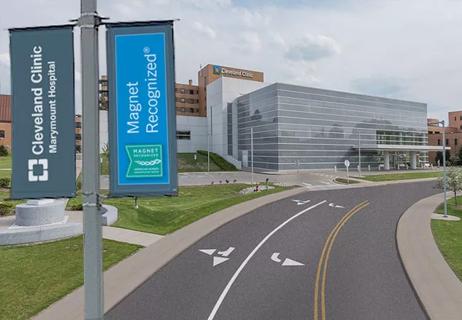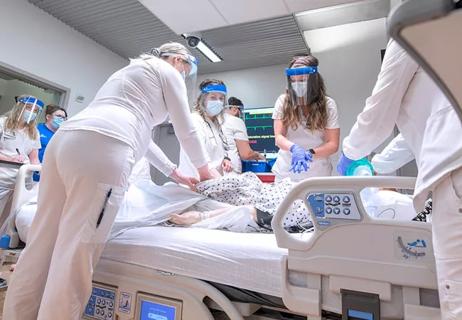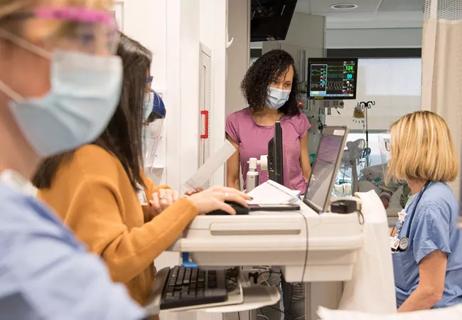Advertisement
A close-up on one of the six tiered huddles improving quality system-wide

Last year, Cleveland Clinic instituted daily tiered huddles to expose and elevate operational information across the system. The huddles include six levels, from Tier 1 (unit level caregivers and their managers/supervisors) to Tier 6 (the CEO and Operations Council). At first glance, it may seem that having a series of huddles would take time away from patient care. But each tier has a purpose, and a closer look at one of them – Tier 2 huddles for managers and directors – reveals their importance.
Advertisement
Cleveland Clinic is a non-profit academic medical center. Advertising on our site helps support our mission. We do not endorse non-Cleveland Clinic products or services. Policy
“When we started Tier 2 huddles, many people were skeptical and thought, ‘Wow! It’s just another meeting,’” says Kathy Saffron, MSN, RN, NE-BC, Nurse Director of Emergency Services and Critical Care at Cleveland Clinic Hillcrest Hospital. She participates in Tier 2 huddles that include emergency services, the ICU, the cardiac/surgical ICU and the coronary care ICU. “After we did them for just a short time, we recognized that we’re coming together as more of a team. Having a full understanding of what’s going on in all of our units has been very helpful.”
Most Tier 2 huddles happen between 8 a.m. and 9:30 a.m., depending on the needs of the specific area, and they last approximately 20 to 30 minutes. Participants use a standardized template to review topics, including potential serious safety events, hospital-acquired infections, falls, codes, bed management, patient length of stay and staffing. “The template provides a defined focus,” says Saffron. “Instead of people coming to huddles and not knowing what to talk about, we have agenda items.”
Shannon Pengel, MSN, RN, NE-BC, ACNO at Cleveland Clinic’s main campus, cites another benefit: “Using standardized questions has helped our managers to all think in a similar fashion,” she says. As a clinical nursing director with the Nursing Institute, Pengel leads a Tier 2 huddle for the areas she is responsible for. “When we started this process, our ICU nurse managers had a better handle on how to look at hospital-acquired infections. But now, because we are all looking at each occurrence the same way, our step-down and floor managers are equally as knowledgeable as our ICU nurse managers,” says Pengel.
Advertisement
In addition to standardization, there’s another key component of most Tier 2 huddles: They are typically interdisciplinary. The emergency services and critical care huddles at Hillcrest Hospital often include nurse managers, a clinical nurse specialist, the nursing operations manager, emergency service providers and a representative from both the ICU intensivist group and the respiratory group.
Bringing everyone together allows the team to identify and rectify issues early on. For example, at the Tier 2 huddle, Samantha Connelly, BSN, RN, Nurse Manager of the ICU at Hillcrest Hospital, reports out on everyone who is intubated. “We noticed we had an opportunity to lighten the sedation of intubated patients and try to get them off ventilators,” says Connelly. “There hadn’t been efficient communication between nursing, respiratory and the doctors before.” Since focusing on this issue in the huddles, the ICU has seen improvement in their spontaneous breathing trials (SBTs) and spontaneous awakening trials (SATs), as well as the number of days on the ventilator.
Nursing professionals at Cleveland Clinic cite several advantages of the Tier 2 huddles:
Advertisement
When caregivers are “in this together,” it achieves the ultimate goal – providing quality patient care. “I love the interdisciplinary huddle approach because it brings everyone together with the same goal,” says Saffron. “It puts the patients first.”
Advertisement
Advertisement

Nurses are well-positioned to appraise and integrate evidence into clinical practice to provide quality patient care

Leadership rounds educate nurses and foster teamwork

Veteran nurse shares his experience as a caregiver and community volunteer

Decision tree amplifies commitment

Hospital earns nine exemplars from the Magnet Recognition Program®

Supporting newly graduated RNs before and after the pandemic

PULSES sets forth six critical steps

Creating a roadmap to get everyone on board